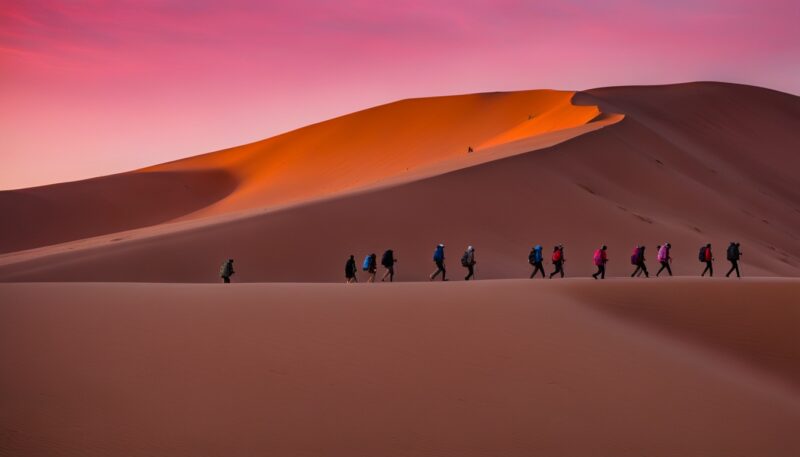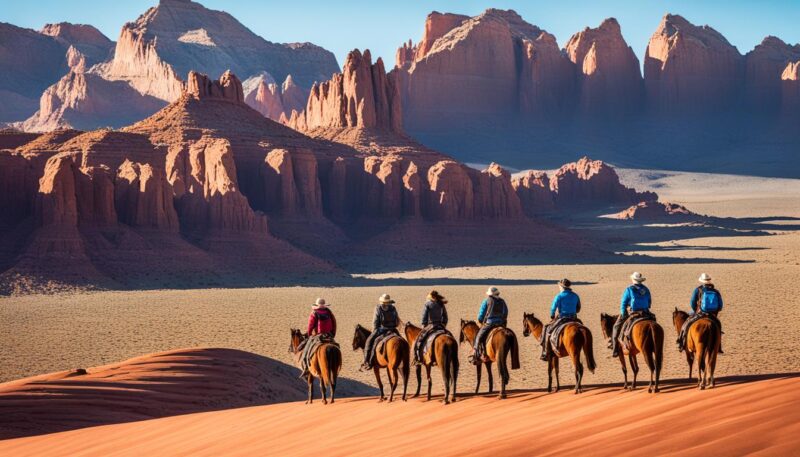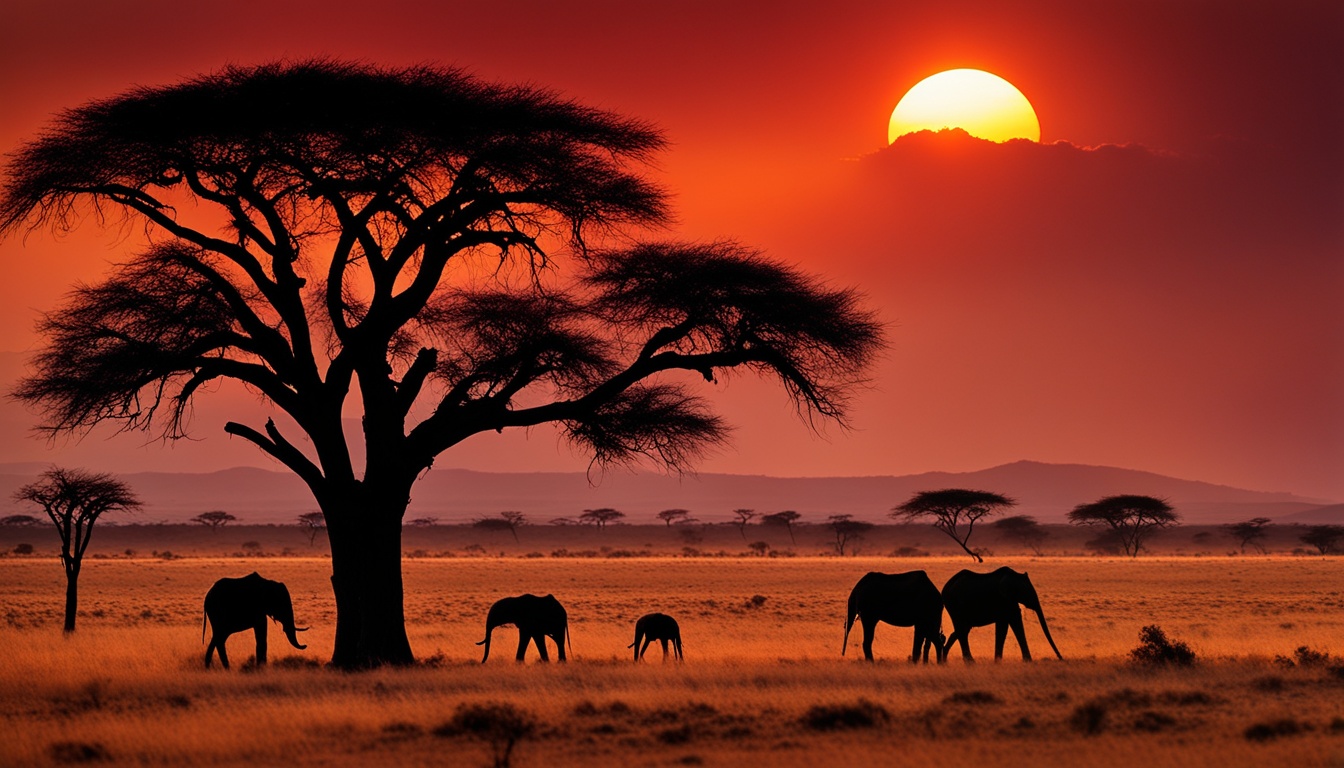Namibia is loved by over 1.5 million people each year, ranking it high among Africa’s favorite spots. This desert nation is known for its stunning nature and rich culture, attracting visitors worldwide. When you visit makes a big difference in your experience. Whether you dream of seeing wildlife up close or wandering Namibia’s breathtaking scenes, knowing the seasons will help you find the best moments.
Namibia welcomes visitors all year, promising amazing weather almost anytime. The dry season, from June to October, is top for safaris and exploring Sossusvlei. Why? With clear skies and cooler weather, wildlife gathers around water spots. April-May and November, the shoulder seasons, also have their perks. You get better deals, see fewer people, and experience both warmer and cooler days.
The rainy season, from December to March, means warmer weather and a chance to explore the coast. It’s ideal for birding. But, there are downsides like closed roads and more humidity.
Key Takeaways
– Namibia is a year-round destination with distinct seasonal offerings
– The dry season (June to October) is prime for safaris and Sossusvlei visits
– Shoulder seasons (April-May, November) offer discounts and fewer crowds
– Rainy season (December to March) brings coastal exploration and birding opportunities
Namibia’s Seasons: A Guide to Optimal Travel
In Namibia, the best time for safaris and Sossusvlei visits is from June to October. This period sees cloudless skies, cold clear nights, and almost no rain. Off the coast, thick morning fog fades by noon. It’s perfect for scaling Sossusvlei’s dunes.
In Etosha National Park, animals come to waterholes, perfect for spotting. Inland, daytime temperatures are 19-24°C (66-75°F). Nights can get as cold as below freezing, making warm layers a must.
Shoulder Seasons (April – May, November): Discounts and Fewer Crowds
April, May, and November offer alternatives to high seasons. In April and May, the land turns green, and dust is washed away. It’s affordable and uncrowded, except for Easter. In November, it’s hot with wildlife still plentiful.
This is the time for discounted lodge rates. With clear air and daytime temps 24-30°C (75-86°F), it’s a great time to visit.
Rainy Season (December – March): Coastal Exploration and Birding
The rainy season brings coastal charm from December to March. The summertime offers pleasant conditions and birdwatching. In February, watch flamingos gather in Etosha pan for breeding.
Temperatures soar, reaching over 40°C (104°F) in the south. The rain makes wildlife harder to spot. Yet, the season offers its own unique beauty with fewer tourists.
Unlock the Best of Namibia: Month-by-Month Guide
Namibia changes its look and feel with each month, offering something unique for every traveler. The country ranges from summer joy at the coast to cool winter nights made for stargazing. This guide shows you the best of Namibia no matter when you visit.
January: Summer Bliss and Coastal Retreats
In January, the summer holidays in Namibia come to an end. Locals return from the cooler central areas to start the new year’s work. Coastal towns like Swakopmund are quiet and perfect for exploring.
Sea temperatures are warmer, and the days are hot and sunny. It’s a great time for adventure or just soaking up the sun. Prepare yourself for an unforgettable time in Namibia.
April: Autumn Splendor and Easter Festivities
April kicks off autumn in Namibia with cool nights and warm days. It’s a perfect season to visit places like Damaraland, the Skeleton Coast, and Sossusvlei. But remember, during Easter, coastal accommodation prices go up.
Head inland to Spitzkoppe or the Erongo Mountains to avoid the crowds. This is a great time for seasonal activities in Namibia’s heartland.
July: Winter Wonderland and Stargazing Nights
In July, Namibia starts its winter, known for dry, sunny days. It is high season, so book your stay early and watch for price changes. Top places to visit include Kolmanskop Ghost Town and the nearby wild horses.
Don’t miss stargazing during the clear desert nights. It’s a planner’s dream for a Namibia vacation.
October: Spring Awakening and Value Season
October welcomes spring in Namibia with warm days and vibrant landscapes. It’s considered low season, so expect fewer tourists and better rates.
The lack of vegetation makes game viewing great in central regions. This is an excellent time to see Namibia without the busy crowds.

Best Time to Visit Namibia: A Comprehensive Overview
Namibia is a gem, offering joy all year. By knowing its climate, you can plan the perfect trip. Regardless of the season, there’s always something exciting to do.
June to October: Safari Season and Dune Trekking
The dry season, from June to October, is perfect for safaris and seeing the Sossusvlei dunes. With clear skies and cool weather, this time is ideal for watching wildlife. Etosha National Park shines then. Trekking Sossusvlei’s dunes is also easier in this dry spell.
December to March: Coastal Escapes and Birding Bonanza
December to March is the summer season, great for coastal adventures and birdwatching. The coast’s holiday feel and ideal weather make it perfect for outdoor parties. It’s also the time to see migrating birds, especially at Etosha National Park. The Etosha pan becomes a hot spot for flamingos and others.
Unlocking the Perfect Moments in Namibia
The best time to visit Namibia is during the dry season, from June to October. This is when wildlife watching is at its peak because animals gather at water holes. You will see desert elephants, black rhinos, and many other animals. The months of April-May and November are also good for spotting wildlife, with fewer tourists and lower costs.
You can also read: Is Germany Safe To Visit
Exploring Namibia’s Diverse Landscapes
Namibia boasts a variety of terrains, from the Sossusvlei’s dunes to the Skeleton Coast. The best time to visit these places is from June to October. This period is perfect for trekking and enjoying the desert with cool temperatures. The months of April, May, and November offer mild weather, ideal for exploring all regions. From December to March, the landscape is covered in greenery, great for coastal visits and bird watching.
Embracing Local Events and Cultural Experiences
Throughout the year, Namibia offers unique local events and shares its cultural heritage. The Easter Holidays in April bring higher prices but also local traditions. Windhoek showcases its German heritage with a lively Oktoberfest in October. You can learn about various cultures all year round, from the San people to the Himba tribe.

Conclusion
Namibia stands out as an amazing place to visit throughout the year. Knowing the best times to see the wildlife, explore the landscapes, or dive into the culture is key. This helps travelers pick when to go for a more personalized experience.
The dry season runs from June to October, perfect for safaris and exploring the dunes. From December to March, the rainy season is great for the coast and watching birds. The times between these, the shoulder seasons, offer a bit of everything and often have lower prices.
Whenever you visit, Namibia’s beauty, history, and animals will be there to wow you. By planning well and being open to what each season brings, you can make your Namibian trip just right for you. It’s about creating a journey that you’ll never forget.
FAQ
What is the best time to visit Namibia?
Namibia is great to visit anytime, but when you go matters a lot. The dry season from June to October is perfect for safaris and seeing Sossusvlei. You’ll get clear skies, lower temps, and see more animals near water.
If you’d like a trade-off, the April to May and November months are great. Rates are lower, there are fewer people, and you’ll find some mix of summer and winter. Yet, from December to March, it’s the rainy season. This time’s warm, good for exploring the coast, and has more birds. But, road closures and high humidity might make it tough.
What are the main factors to consider when planning a trip to Namibia?
When planning, remember the weather, where you can see wildlife, and how crowded it’ll be. Head to Namibia from June to October for the best safari and Sossusvlei experiences. For exploring the coast and bird watching, December to March is better. If you’re looking for a mix, April to May and November are perfect. Rates drop and there are fewer tourists.
What are the weather patterns in Namibia throughout the year?
Namibia is mostly dry, with clear seasons. June to October is dry, offering perfect safari weather. From December to March, it’s warmer and great for walking on the coast. But, watch out for road closures and the high humid. April to May and November mix both types of weather.
What are the best activities and experiences to enjoy in Namibia during the different seasons?
If you visit from June to October, safaris and seeing Sossusvlei are top picks. For a coastal adventure and bird watching, head over from December to March. The months of April to May and November are good for a mix. You’ll find lower prices and fewer tourists during these times.
How does the timing of my visit impact wildlife viewing in Namibia?
Choosing when to visit Namibia is key for seeing wildlife. June to October is best as the animals gather around water sources. Here, you might see desert elephants and black rhinos. April to May and November are also good, with less crowd. Plus, rates are lower.
What are some of the unique local events and cultural experiences in Namibia?
In Namibia, local events and culture add to the travel joy. During Easter in April, the coast prices go up but there’s much to see and learn. The Windhoek Oktoberfest in October celebrates the German ties. Throughout the year, you can dive into diverse local cultures, from the San to the Himba people.
Source Links
- https://blog.viatu.com/en/blog/the-best-time-to-travel-to-namibia
- https://www.lonelyplanet.com/articles/best-time-to-visit-namibia
- https://www.wildernesstravel.com/africa/namibia/best-time-visit/
